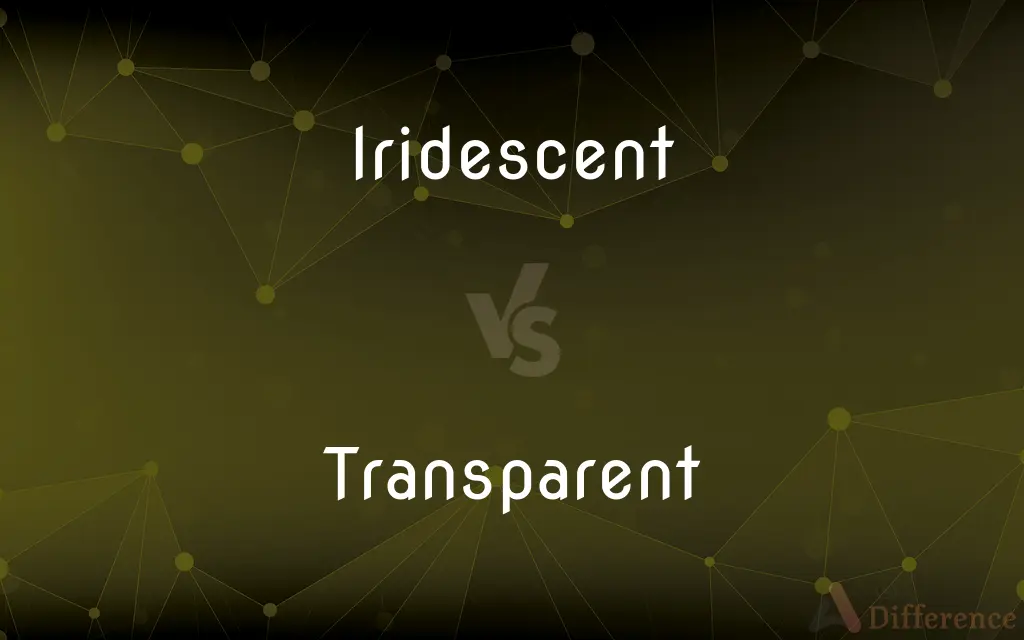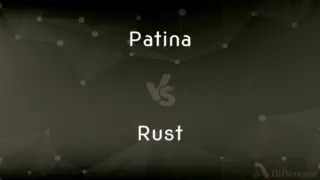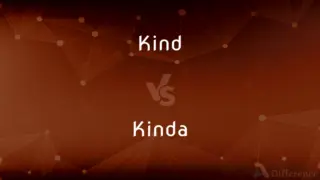Iridescent vs. Transparent — What's the Difference?
By Tayyaba Rehman & Maham Liaqat — Updated on March 25, 2024
Iridescent describes a surface that displays shifting rainbow colors depending on the angle of view, while transparent refers to a material that allows light to pass through, enabling clear vision of objects beyond.

Difference Between Iridescent and Transparent
Table of Contents
ADVERTISEMENT
Key Differences
Iridescence is a visual phenomenon where an object's surface seems to gradually change color as the angle of view or the angle of illumination changes. This effect is often seen in soap bubbles, peacock feathers, and oil slicks on water. It is caused by the interference of light waves reflected from multiple surfaces within a translucent material. On the other hand, transparency is the quality of a material that permits light to pass through it without significant scattering, so objects behind can be distinctly seen. Clear glass and some plastics are prime examples of transparent materials, used in windows and lenses to allow an unobstructed view of the outside world.
While iridescence is primarily a surface or material characteristic that adds visual appeal and is often used in art, jewelry, and fashion for its captivating color effects, transparency is a functional attribute critical in various applications like eyewear, photography, and architecture. It emphasizes clarity and visibility, allowing the transmission of light and the clear perception of objects.
The iridescent effect relies on the physical structure of the surface, including microscopic grooves or layers that diffract light, creating a spectrum of colors that change with perspective. Conversely, transparent materials are structured to minimize light absorption and reflection, ensuring that light passes through with minimal distortion, making them essential for vision and safety in numerous contexts.
In decorating and design, iridescent materials are chosen for their aesthetic qualities, adding a dynamic and colorful element to spaces and objects. Transparent materials, however, are selected for their ability to preserve and enhance spatial continuity, visibility, and interaction with the environment, offering both functionality and a sense of openness.
Iridescence and transparency serve different purposes and appeal to different senses: iridescence captures attention through changing colors and visual intrigue, whereas transparency is valued for its practicality in promoting clear vision and light transmission.
ADVERTISEMENT
Comparison Chart
Definition
Displays shifting colors depending on the angle.
Allows light to pass through clearly.
Cause
Caused by light interference within material layers.
Caused by minimal light scattering within the material.
Applications
Used in fashion, art, and decoration for aesthetic appeal.
Used in windows, lenses, and containers for functionality.
Effect on Light
Reflects and refracts light to create colors.
Transmits light without altering it significantly.
Visual Impact
Adds dynamic color changes and visual intrigue.
Provides clarity and allows for unobstructed views.
Compare with Definitions
Iridescent
Exhibits changing colors.
The iridescent soap bubble shimmered in the sunlight.
Transparent
Can see through it.
The transparent waters of the Caribbean were breathtaking.
Iridescent
Surface effect causing color shifts.
The peacock's feathers displayed an iridescent glow.
Transparent
Allows clear passage of light.
The transparent glass windows lit up the room.
Iridescent
Aesthetic and decorative.
The designer used iridescent paint for a stunning effect.
Transparent
Used in practical applications.
Transparent materials are essential for eyeglasses.
Iridescent
Caused by internal structures.
The iridescent pattern on the CD is due to tiny grooves.
Transparent
Materials that enable visibility.
The scientist observed the specimen through a transparent container.
Iridescent
Seen in nature and art.
Iridescent colors in seashells attract collectors.
Transparent
Emphasizes clarity and openness.
The architect's use of transparent panels enhanced the building's design.
Iridescent
Producing a display of lustrous, rainbowlike colors
An iridescent oil slick.
Iridescent plumage.
Transparent
Capable of transmitting light so that objects or images can be seen as if there were no intervening material.
Iridescent
Brilliant, lustrous, or colorful in effect or appearance
"The prelude was as iridescent as a prism in a morning room" (Carson McCullers).
Transparent
Permeable to electromagnetic radiation of specified frequencies, as to visible light or radio waves.
Iridescent
(not comparable) Producing a display of lustrous, rainbow-like colors; prismatic.
Transparent
So fine in texture that it can be seen through; sheer.
Iridescent
Brilliant, lustrous, or colorful.
Transparent
Easily seen through or detected; obvious
Transparent lies.
Iridescent
Having colors like the rainbow; exhibiting a play of changeable colors; nacreous; prismatic; as, iridescent glass. See iridescence.
Transparent
Free from guile; candid or open
Transparent sincerity.
Iridescent
Varying in color when seen in different lights or from different angles;
Changeable taffeta
Chatoyant (or shot) silk
A dragonfly hovered, vibrating and iridescent
Transparent
Open to public scrutiny; not hidden or proprietary
Transparent financial records.
Iridescent
Having a play of lustrous rainbow-like colors;
An iridescent oil slick
Nacreous (or pearlescent) clouds looking like mother-of-pearl
A milky opalescent (or opaline) luster
Transparent
(Obsolete) Shining through; luminous.
Transparent
(of a material or object) See-through, clear; having the property that light passes through it almost undisturbed, such that one can see through it clearly.
The waters of the lake were transparent until the factory dumped waste there.
Transparent
(of a system or organization) Open, public; having the property that theories and practices are publicly visible, thereby reducing the chance of corruption.
Transparent
Obvious; readily apparent; easy to see or understand.
His reasons for the decision were transparent.
I love playing poker with Steve, because he's so transparent.
Transparent
(signal processing) Having the property of transparency, i.e. sufficiently accurate that the compressed result is perceptually indistinguishable from the uncompressed input.
Transparent
(computing) Not noticeable because it happens automatically or in the background; invisible.
Transparent
Of an image or animated gif, having parts that do not overwrite the color of the background the image is placed over.
Transparent
Having the property of transmitting rays of light, so that bodies can be distinctly seen through; pervious to light; diaphanous; pellucid; as, transparent glass; a transparent diamond; - opposed to opaque.
Transparent
Admitting the passage of light; open; porous; as, a transparent veil.
Transparent
Transmitting light; able to be seen through with clarity;
The cold crystalline water of melted snow
Crystal clear skies
Could see the sand on the bottom of the limpid pool
Lucid air
A pellucid brook
Transparent cristal
Transparent
So thin as to transmit light;
A hat with a diaphanous veil
Filmy wings of a moth
Gauzy clouds of dandelion down
Gossamer cobwebs
Sheer silk stockings
Transparent chiffon
Vaporous silks
Transparent
Free of deceit
Transparent
Easily understood or seen through (because of a lack of subtlety);
A transparent explanation
A transparent lie
Common Curiosities
Can a material be both iridescent and transparent?
While unusual, some materials may exhibit both qualities under different conditions, but they generally serve different visual functions.
Why do peacock feathers look iridescent?
Peacock feathers look iridescent due to microscopic structures that diffract light, creating a spectrum of colors that change with the viewing angle.
What causes the iridescent effect?
The iridescent effect is caused by the interference of light rays reflecting off multiple layers within a material or surface structure.
Is iridescence a color?
Iridescence is not a single color but a surface phenomenon that creates a spectrum of colors depending on the light and viewing angle.
What is a transparent material?
A transparent material is one that allows light to pass through it clearly, enabling objects behind to be seen distinctly.
Can iridescence be artificially created?
Yes, iridescence can be artificially created on surfaces through techniques that replicate the natural structures responsible for the effect, like coating or layering.
What makes water transparent?
Water is transparent because its molecular composition does not absorb or scatter light significantly, allowing clear passage of light.
What does "iridescent" mean?
Iridescent refers to a surface showing shifting colors as the angle of view or illumination changes.
How is transparency useful in everyday life?
Transparency is crucial for visibility and safety in everyday objects like windows, glasses, and vehicle windshields, allowing clear vision through them.
Why is glass transparent?
Glass is transparent because its atomic structure allows light to pass through it with minimal absorption or reflection.
What are the benefits of using transparent materials in architecture?
Transparent materials in architecture enhance natural light entry, visibility, and the aesthetic integration of indoor and outdoor spaces.
Are all crystals transparent?
Not all crystals are transparent; transparency depends on the crystal's structure and impurities, which can affect light transmission.
What's the difference between translucent and transparent?
Translucent materials allow light to pass through but scatter it, preventing clear vision through the material, unlike transparent materials.
How is iridescence applied in fashion?
In fashion, iridescence is used for its visual appeal, adding dynamic, changing colors to fabrics and accessories.
Is iridescence always natural?
Iridescence can be both natural, as seen in butterflies and bird feathers, and artificially created in materials like films and paints for decorative purposes.
Share Your Discovery

Previous Comparison
Patina vs. Rust
Next Comparison
Kind vs. KindaAuthor Spotlight
Written by
Tayyaba RehmanTayyaba Rehman is a distinguished writer, currently serving as a primary contributor to askdifference.com. As a researcher in semantics and etymology, Tayyaba's passion for the complexity of languages and their distinctions has found a perfect home on the platform. Tayyaba delves into the intricacies of language, distinguishing between commonly confused words and phrases, thereby providing clarity for readers worldwide.
Co-written by
Maham Liaqat













































